Full Stack Web and Mobile Apps Development Company in India
What Is Python Development – A Beginners To Advanced Guide
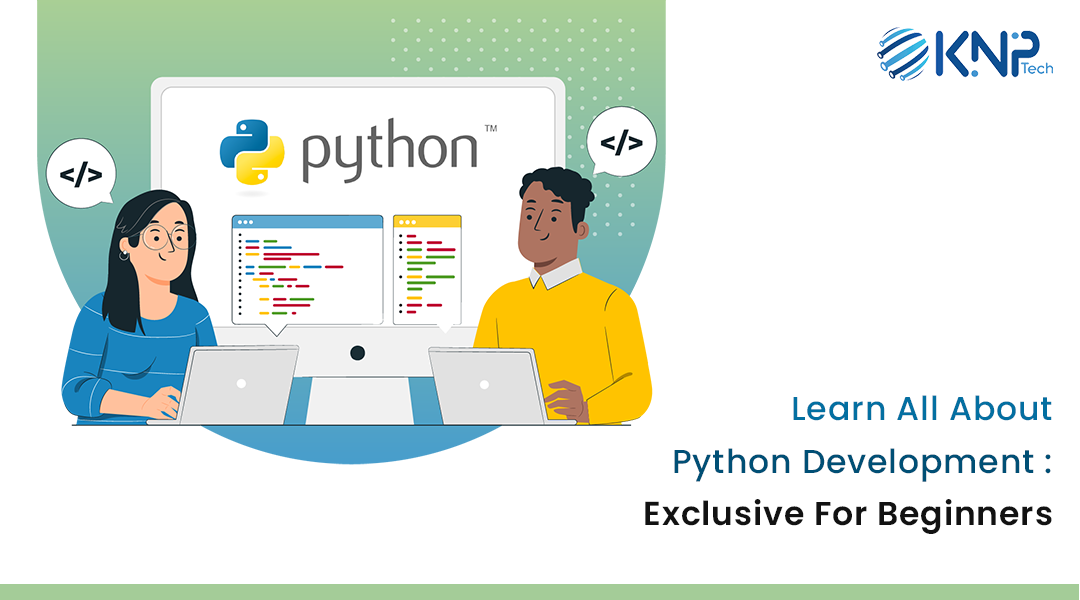
Author
Priyank Panchal,
November 15, 2023
Hey reader! You already have an idea about what Python is, or you have gotten the Python overview from somewhere else! But in this blog, we are not only going to provide an overview of Python programming language; we are going to describe the future trends, it’s working, and examples of applications based on Python Programming language.
Let’s begin with the exclusive read!
Python Overview
Python is one of the most widely used programming languages and one of the most popular ones. It is effective, can be used in a variety of contexts, and is simple to master.
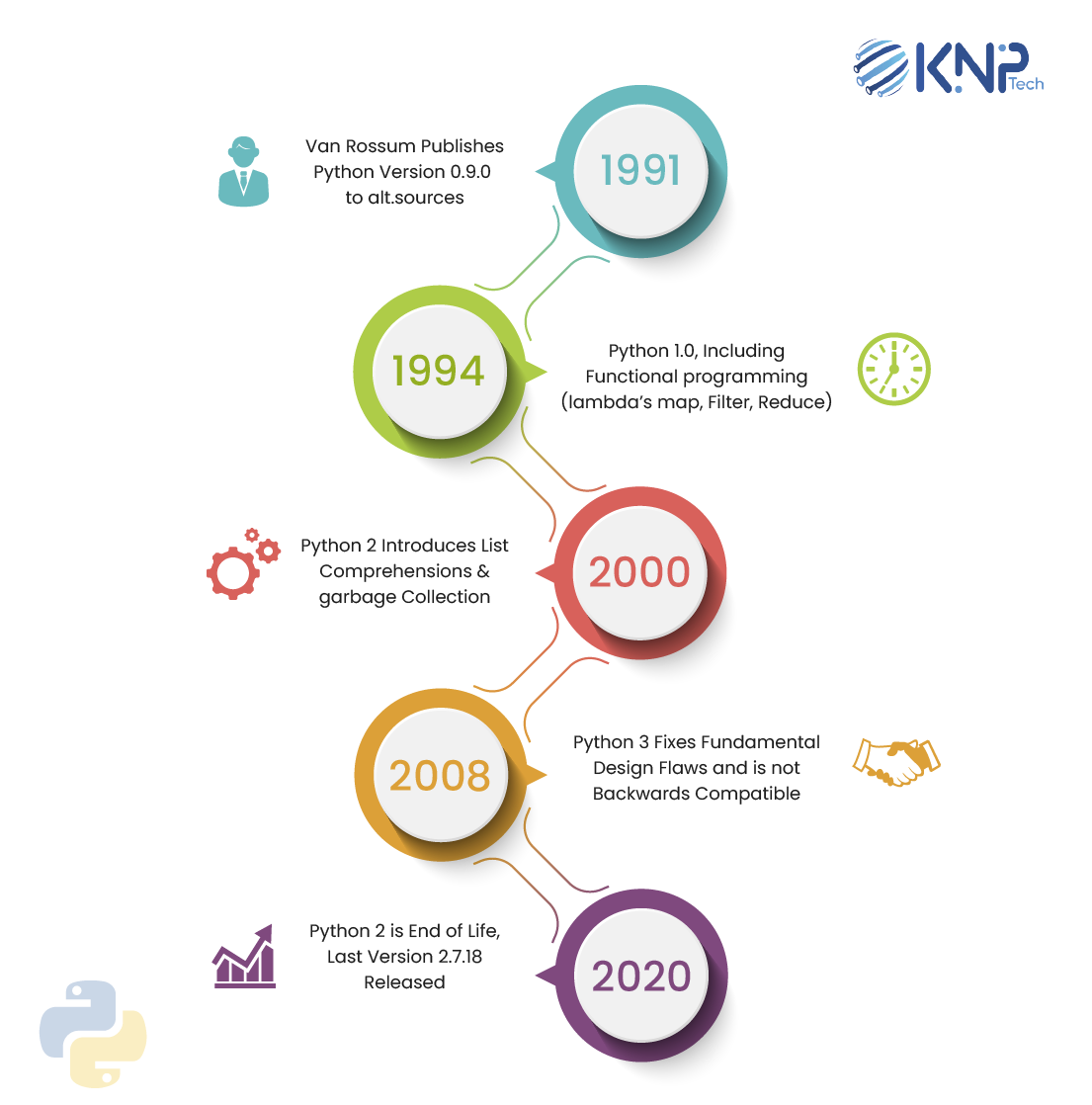
So, as the timeline suggests, Python’s initial release was in 1991. It is a user-friendly, high-level programming language that has become more popular in every aspect of the IT industry.
Talking about the strength of Python development – it is its
Syntax, which makes coding and its maintenance more manageable.
Do you still think Python programming is overhyped?
Well, it’s not!
According to Statista, Python is 3rd most with 49.28% ratings for the most used programming language among developers worldwide as of 2023.
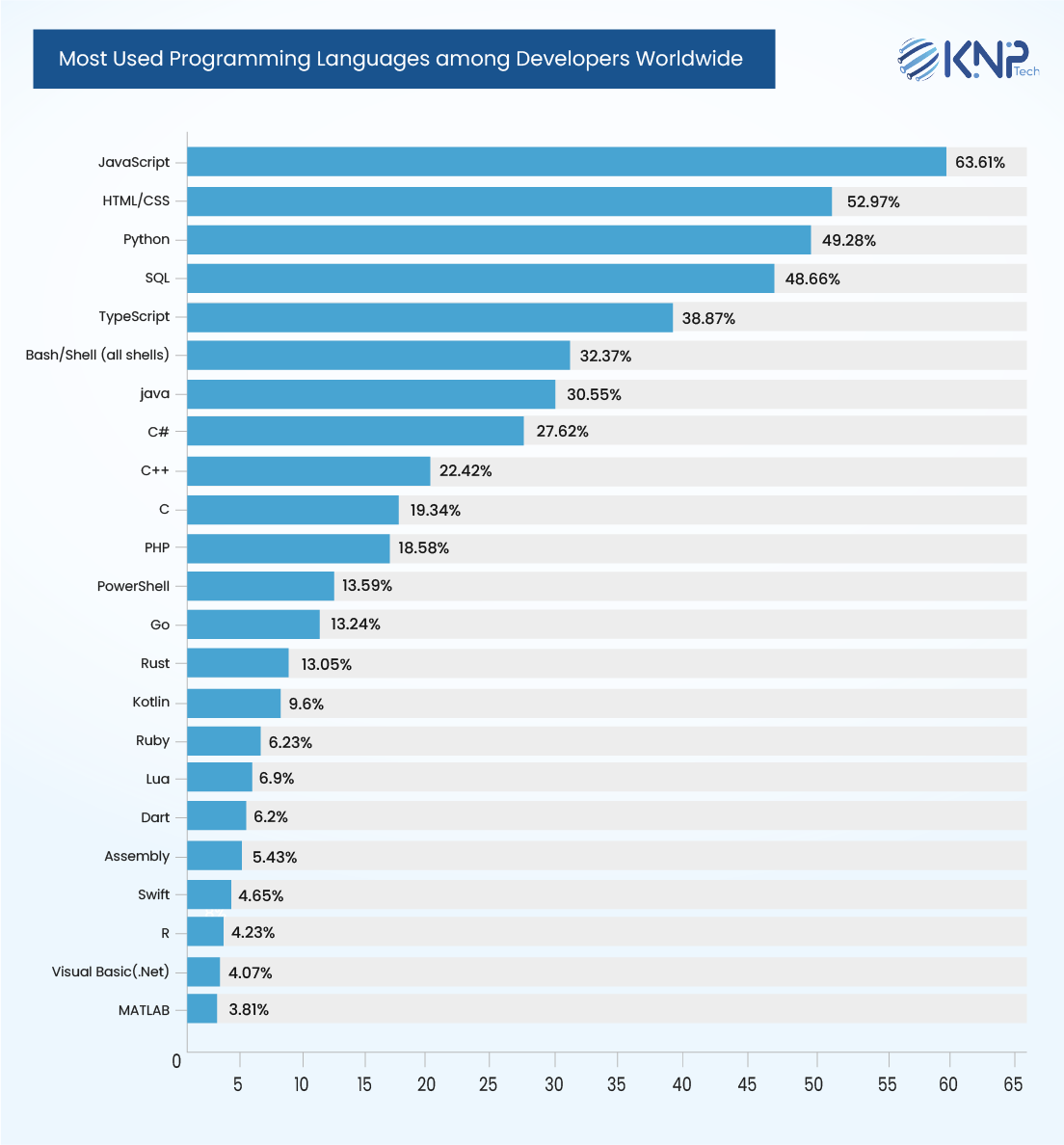
At this point, the Learning Curve of Python Programming is very easy.
Talking more about Python programming, another major benefit is Python Programming’s Library.
So, what’s in the Python Libraries Collection?
A Library is a kind of module or package that can be used in Python development for various purposes, from web development to data analysis. Another noteworthy aspect of Python is its versatility, as it supports programming paradigms such as object-oriented and functional programming.
Now, what has made Python so popular? Is its domains like
-
-
- Django, Flask for web development
- PyTorch, TensorFlow for Machine Learning
- NumPy, Pandas for data science
- Scripting/Automation due to its ease of use and extensive community support.
-
Accessibility, Versatility, and Readability are the core reasons why businesses and developers are more inclined towards Python programming and Python Development.
5 Benefits of Python Programming Language
So, after getting an overview of Python programming language -, let’s talk about the critical benefits of Python development for business.
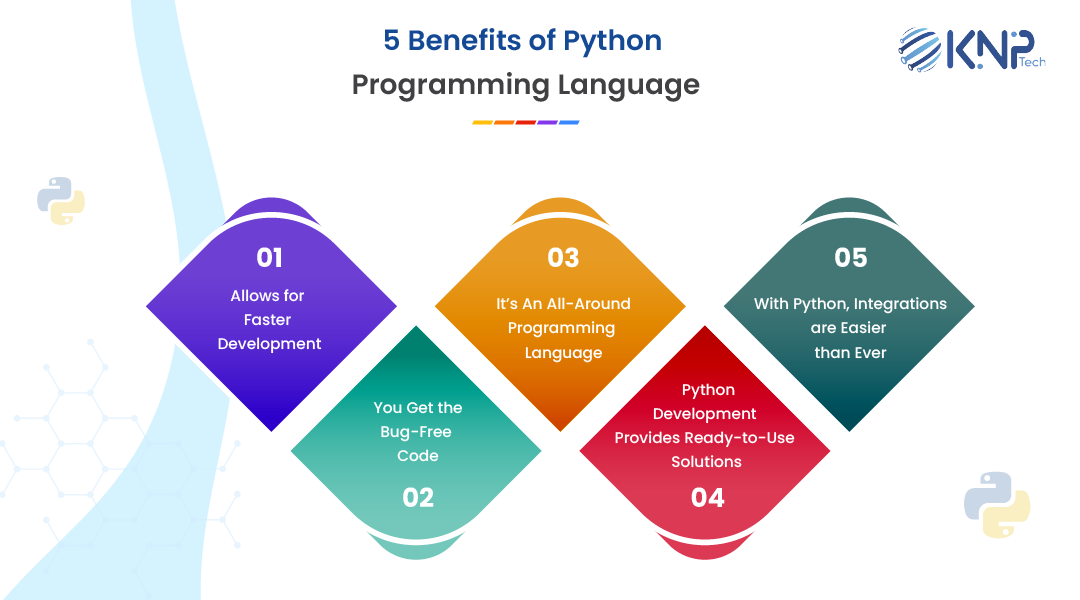
If you are looking to use Python Programming for your next project of web or app development, consider the following advantages.
1: Allows for Faster Development
If you read again the section in the Python Overview – the core principle of any business going after Python development is the simplicity of the language.
And for the same reason, the development becomes really fast. Well, many elements contribute – such as reusable elements, ready-to-use code blocks from community members and developers for free, etc.
Not only this, it helps in increasing productivity because writing code in Python is relatively easy. That allows businesses and startups to create and have MVP on board really quickly, which ultimately leads to publishing the product in the market as soon as possible.
2: You Get The Bug-Free Code
Do you know the term Unit Testing? Well, it is a feature that allows the testing and checking of a small portion of the codes even before the whole part of the app code is ready.
Python has an in-built feature of this Unit-Testing Feature.
So, this unit testing provides businesses with a bug-free code. Now, a bug-free code serves an excellent final product, and that will save a considerable time in correcting mistakes.
As a result, the code is of better quality; the product is delivered faster and at a decreased cost.
3: It’s An All-Around Programming Language
Python is often regarded as one of the most flexible languages in the industry.
Now, with this core feature of flexibility – Python programming can be used for a wide array of projects, and Python development can be implemented everywhere.
- Desktop Software
- Web Application.
- Prototype
- OR ERP software
be it anything – python development has covered it all. Python’s adaptability, versatility, and strong community have led to a rise in demand for development services built on the language.
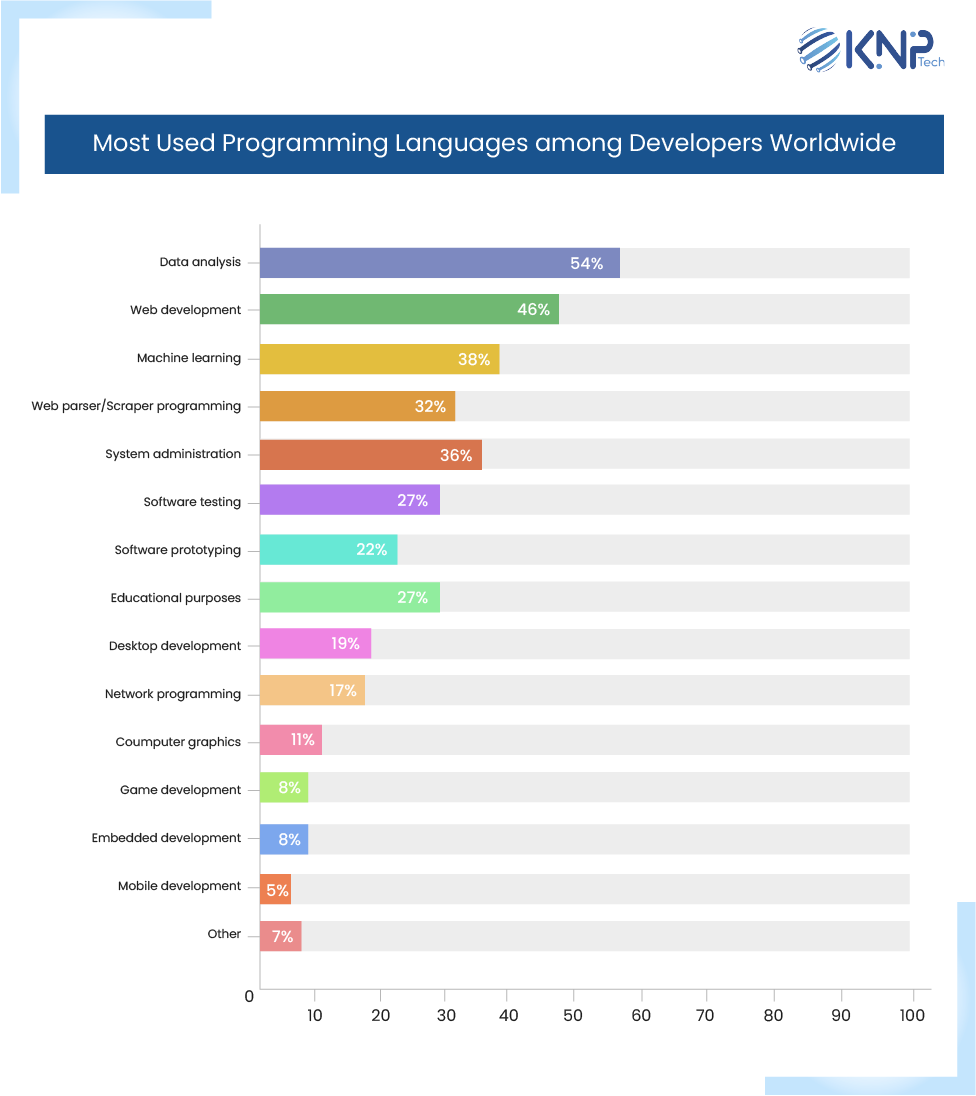
According to Statista, Data Analysis and Web Development are the best cases of Python Development.
4: Python Development Provides Ready-to-Use Solutions
The fact that there are a large number of ready-to-use modules, packages, components, libraries, and frameworks available on the website of The Python Package Index is among the most beneficial aspects of using Python as a programming language.
Many essential programming activities have been scripted and incorporated into the libraries, allowing developers to cut down on coding time when using these tools drastically.
5: With Python, Integrations are Easier than Ever
Have You Heard “Glue Language”? Well, it is used as a synonym for Python programming development.
We do not deny the fact that Python programming has characteristics like the ability and readily integration capabilities, which makes “Magic Glue” and, as a result, the capability to communicate with many other technologies and platforms.
In addition to this, the Python software repository known as PyPI makes hundreds of modules developed by third parties available to users. Because of this, users are able to connect Python with a variety of different services easily.
Python Application Examples
As we have already discussed in the Python overview – The language supports cross-platform operating systems. With this feature, application development becomes much easier.
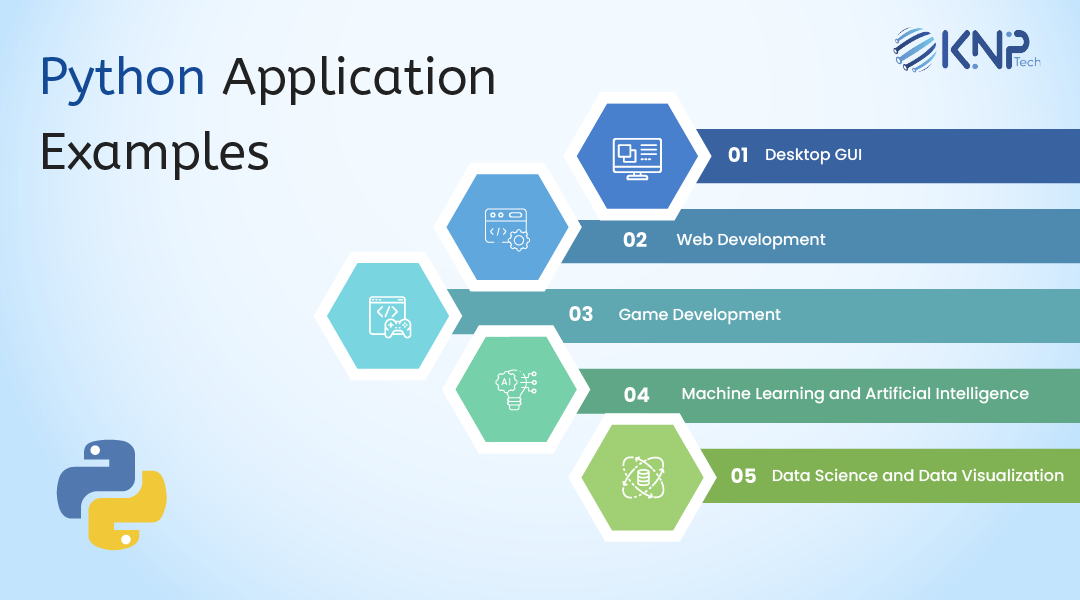
- BitTorrent
- YouTube
- Dropbox etc
are some of the famous applications which are based on Python Development. But in this section, we have provided the type of application that can be built using Python Programming.
Desktop GUI
Many businesses prefer Python programming for Desktop Application development. But if you Python development can be used in TKinter Library to develop user interfaces.
- Kivy
- weWidgets
- PYQT
are some other valuable toolkits with which you can create applications.
You can start with creating simple applications such as Calculators and to-do apps and go ahead and make much more complicated applications.
Web Development
Well, as we have already seen by stats, Python programming is widely used in Web applications.
Why So?
Well, the answer is because of Python Frameworks.
Popular frameworks include Django, Flask, and Pyramid. There is common backend logic that goes into developing these frameworks and a variety of libraries that can help integrate protocols and even aid in the processing of JSON, XML, E-Mail, and so much more.
Game Development
There are literally hundreds of examples of games being produced using Python as the primary programming language. PySoy is a 3D game engine that supports Python 3, while PyGame is a library that offers functionality as well as a library for game creation. Both of these libraries are examples of game development libraries.
Python has been used in the development of a wide variety of popular video games, including Disney’s Toontown Online, Vega Strike, and others.
Machine Learning and Artificial Intelligence
You’ll agree with me when we say that the next decade will be all about AI and machine learning.
In practically every business and research-focused department, enormous machine learning/deep learning models and architectures are starting to be applied to tackle significant data challenges.
Every business stands to benefit from ML, whether it’s a cancer drug-generating ML algorithm or a model that can spot unsafe highway activities for an autonomous vehicle.
In a nutshell, supervised, semi-supervised, and unsupervised tasks in the visual and non-visual domains may be distinguished in machine learning.
Data Science and Data Visualization
There are many different applications of Python, but data science may be the most important one.
Python programmers of various skill levels are able to effortlessly visualize and manually extract relevant insights from enormous public and private datasets by making use of code dependencies that have already been incorporated, such as Pandas, NumPy, or Matplotlib. These capabilities are available both on-premises and in the cloud.
Developers may even synthesize data science operations with machine learning models at a high level to extract, visualize, and forecast features from unstructured data (for example, imaging data, time-series stock market data, or home price projections). This can be done to extract, visualize, and predict features from unstructured data.
In addition to this, open-source Github repositories are jam-packed to the brim with business-level Python applications, such as NLP-driven sentiment and hazardous comment categorization or future sales projections.
In addition, communities dedicated to data science, such as Kaggle, provide an additional source of motivation that may help you initiate the development of innovative data science solutions to significant business challenges.
Future of Python Programming
The future of Python programming and development is promising
Due to its adaptability, Python has become a popular choice for use in cutting-edge research. Its widespread library support and user-friendliness make it a practical choice for a variety of business applications.
Python’s sustained dominance in the fields of data science and machine learning is attested to by the widespread use of Python libraries such as TensorFlow and PyTorch. Because of the language’s ease of use, it has garnered support from a large number of developers.
Additionally, owing to frameworks such as Django and Flask, Python is becoming increasingly popular for use in web development. As a result of the productivity increase provided by these frameworks, Python has emerged as a leading candidate for the development of web applications that are easy to maintain.
Python’s influence has expanded as a result of the programming language’s adoption by forward-thinking technologies such as blockchain and the Internet of Things (IoT). Because it is portable, it may be helpful in a wide range of settings and situations.
The future of Python programming and software development seems promising as a result of the language’s adaptability, widespread community support, and inclusion of cutting-edge technologies. It is the language of choice for both well-established enterprises and application sectors that are on the cutting edge, so it is reasonable to predict that it will continue to be relevant in the future.
Python Development Trends
Now, in this section – we have outlined the Python development trends that you must follow if you are looking to invest in Python development.
- • Famous for use in modular systems and architecture based on microservices.
- • Both FastAPI and Quart improve the effectiveness of multitasking.
- • The creation of websites is increasingly making use of asynchronous coding.
- • Repercussions are caused by containerization and orchestration technologies such as Docker and Kubernetes.
- • Python is suitable for the automation and administration of configurations in accordance with the DevOps concept.
- • A rise in the use of serverless computing platforms (such as AWS Lambda and Azure Functions, for example).
- • Advantage over competitors as a result of quick development cycles and interoperability with serverless architecture.
- • Python is a programming language that is extensively utilized in data science and machine learning.
- • A number of packages and tools, such as Jupyter Notebooks, Scikit-Learn, and Pandas, highlight Python’s importance as a tool for data analysis and machine learning.
Wrap-Up
So, there are endless opportunities for Python development and programming. We hope that this guide has served you as the best guide. No matter if you are a beginner or advanced – we have provided information for all.
If you are in serious thought to have Python development for your next project- whatever it is – like web development, data science problem, etc. KNP Technologies is at your service.
Contact Us to learn more and explore everything about Python development.
FAQs
Question: 1 What comprises Python development? Why is it widely popular among experienced developers?
Answer: Programming with the Python programming language entails developing software applications. Thanks to its intuitive design and large library support, it is a popular choice among both novice and expert developers. Its simplicity, readability, and adaptability make it ideal for both groups.
- Question: 2 What are the outstanding features of Python that make it a preferred choice for a range of applications?
Answer: Python is unique among programming languages due to its syntax, its standard libraries’ cross-platform compatibility, and its support for numerous paradigms. Web development, data science, AI, automation, and many more areas may benefit from its adaptability.
- Question: 3 How does Python accommodate object-oriented programming (OOP), and what advantages does OOP bring to Python development?
Answer: By facilitating the organisation of code via objects and classes, Python fully adopts OOP ideas. While making software system design and maintenance easier, OOP encourages code reusability, modularity, and scalability.
- Question: 4 Is Python suitable for web development? What are the used frameworks for building web applications?
Answer: Of course! Web developers often use Python. Building scalable web apps has never been simpler than using popular web frameworks like Flask and Django.
While Django is lauded for its extensive feature set, Flask is known for its flexibility and approachability.
- Question: 5 What guidance and steps would you recommend for beginners embarking on the Python development journey, and how can one progress from a novice to an adept Python developer?
Answer: Python provides a wealth of resources for newcomers, including tutorials, courses, and coding challenges. Working on real-world projects, contributing to open-source efforts, and delving into fields like web frameworks and machine learning are all possible as they advance. This systematic approach enables anyone to go from a novice to a proficient Python coder.
